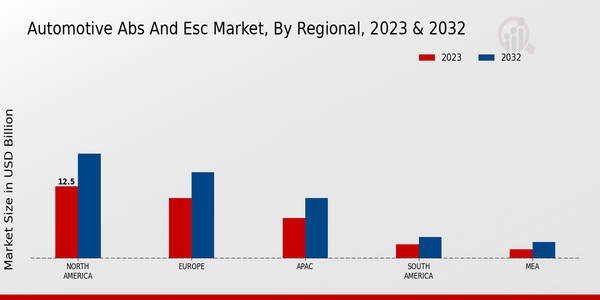Increasing Global Vehicle Production
The Global Automotive ABS and ESC Market Industry is also driven by the increasing production of vehicles worldwide. As global vehicle production rises, so does the demand for safety features such as ABS and ESC. For instance, the automotive industry is projected to produce over 100 million vehicles annually by 2025, necessitating the integration of advanced safety systems in these vehicles. This surge in production is likely to bolster the market for ABS and ESC technologies, contributing to the anticipated growth trajectory that sees the market reaching 59.8 USD Billion by 2035. The correlation between vehicle production and safety system adoption underscores the importance of these technologies in modern automotive design.
Increasing Vehicle Safety Regulations
The Global Automotive ABS and ESC Market Industry is significantly influenced by the stringent vehicle safety regulations imposed by governments worldwide. These regulations mandate the incorporation of advanced safety features, including Anti-lock Braking Systems (ABS) and Electronic Stability Control (ESC), in new vehicles. For instance, the European Union has implemented regulations that require all new passenger cars to be equipped with ESC systems. This regulatory push not only enhances vehicle safety but also drives market growth, as manufacturers strive to comply with these standards, contributing to the projected market value of 37.2 USD Billion in 2024.
Growing Consumer Awareness of Vehicle Safety
Consumer awareness regarding vehicle safety is on the rise, significantly impacting the Global Automotive ABS and ESC Market Industry. As drivers become more informed about the benefits of ABS and ESC systems, they increasingly prioritize these features when purchasing vehicles. This shift in consumer behavior is evident in various markets, where safety ratings and features are prominently highlighted in marketing campaigns. Consequently, manufacturers are compelled to enhance their offerings to meet consumer expectations, thereby driving the adoption of ABS and ESC technologies. This growing demand is expected to contribute to the market's expansion, aligning with the projected figures for 2024 and beyond.
Expansion of Electric and Autonomous Vehicles
The rise of electric and autonomous vehicles is reshaping the Global Automotive ABS and ESC Market Industry. These vehicles often require advanced safety systems to ensure optimal performance and safety. For instance, autonomous vehicles rely heavily on sophisticated ABS and ESC systems to maintain stability and control during operation. As the market for electric and autonomous vehicles expands, the demand for integrated safety systems is likely to increase. This trend not only supports the growth of the ABS and ESC market but also aligns with the projected market value of 37.2 USD Billion in 2024, as manufacturers adapt to the evolving automotive landscape.
Technological Advancements in Automotive Systems
Technological innovation plays a pivotal role in the Global Automotive ABS and ESC Market Industry. The integration of advanced sensors, artificial intelligence, and machine learning into ABS and ESC systems enhances their performance and reliability. For example, the development of predictive braking systems that utilize real-time data to anticipate potential skidding situations exemplifies this trend. As these technologies evolve, they are expected to improve vehicle safety and stability, thereby increasing consumer demand. This trend aligns with the anticipated market growth, reaching an estimated 59.8 USD Billion by 2035, reflecting a compound annual growth rate of 4.41% from 2025 to 2035.






















